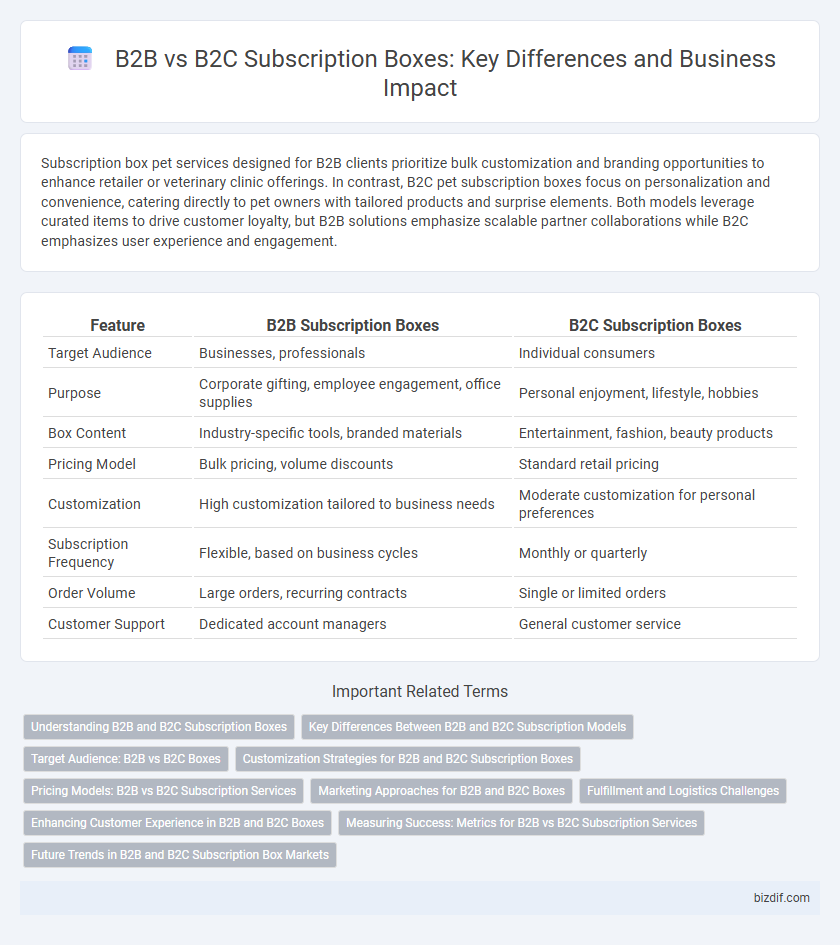Subscription box pet services designed for B2B clients prioritize bulk customization and branding opportunities to enhance retailer or veterinary clinic offerings. In contrast, B2C pet subscription boxes focus on personalization and convenience, catering directly to pet owners with tailored products and surprise elements. Both models leverage curated items to drive customer loyalty, but B2B solutions emphasize scalable partner collaborations while B2C emphasizes user experience and engagement.
Table of Comparison
| Feature | B2B Subscription Boxes | B2C Subscription Boxes |
|---|---|---|
| Target Audience | Businesses, professionals | Individual consumers |
| Purpose | Corporate gifting, employee engagement, office supplies | Personal enjoyment, lifestyle, hobbies |
| Box Content | Industry-specific tools, branded materials | Entertainment, fashion, beauty products |
| Pricing Model | Bulk pricing, volume discounts | Standard retail pricing |
| Customization | High customization tailored to business needs | Moderate customization for personal preferences |
| Subscription Frequency | Flexible, based on business cycles | Monthly or quarterly |
| Order Volume | Large orders, recurring contracts | Single or limited orders |
| Customer Support | Dedicated account managers | General customer service |
Understanding B2B and B2C Subscription Boxes
B2B subscription boxes cater to businesses by offering bulk products, customized solutions, and scalable options tailored to professional needs, emphasizing efficiency and cost-effectiveness. In contrast, B2C subscription boxes focus on personalized experiences, individual preferences, and consumer convenience, often featuring curated items for personal use. Understanding these distinctions is crucial for marketers aiming to target the right audience with relevant subscription box offerings.
Key Differences Between B2B and B2C Subscription Models
B2B subscription boxes prioritize bulk ordering, customization, and recurring delivery schedules to support business operations, whereas B2C boxes emphasize personalized experiences, trends, and convenience for individual consumers. Pricing strategies in B2B models often include volume discounts and longer commitments, while B2C subscriptions focus on affordability and flexibility to attract diverse end-users. Customer relationship management differs, with B2B requiring dedicated account support and B2C leveraging automated marketing and social engagement.
Target Audience: B2B vs B2C Boxes
B2B subscription boxes primarily target businesses seeking solutions that enhance employee engagement, corporate gifting, or industry-specific needs, often emphasizing customization and bulk quantities. In contrast, B2C boxes focus on individual consumers aiming for personal enjoyment, convenience, or niche interests, prioritizing curated experiences and variety. Understanding these distinct target audiences is crucial for tailoring marketing strategies and product offerings effectively.
Customization Strategies for B2B and B2C Subscription Boxes
Customization strategies for B2B subscription boxes emphasize scalability, brand alignment, and product relevance tailored to client industries, often incorporating bulk personalization options and corporate branding elements. In contrast, B2C subscription boxes focus on individual preferences, seasonal trends, and personalized user experiences, utilizing data analytics and customer feedback to curate unique and engaging products. Both approaches leverage targeted customization but differ in scale, personalization depth, and customer relationship dynamics.
Pricing Models: B2B vs B2C Subscription Services
B2B subscription boxes typically feature tiered pricing models based on volume and customization options, catering to diverse business needs and allowing bulk discounts. B2C subscription services usually employ fixed or flexible pricing models, emphasizing affordability and recurring revenue through monthly or quarterly plans. Pricing strategies for B2B prioritize scalability and ROI, while B2C models focus on customer acquisition and retention through competitive, value-driven pricing.
Marketing Approaches for B2B and B2C Boxes
Marketing approaches for B2B subscription boxes focus on personalized solutions, emphasizing ROI, product utility, and long-term business relationships to meet corporate client needs. B2C subscription box marketing leverages emotional appeal, lifestyle alignment, and social media engagement to attract individual consumers through experiential and trend-driven content. Tailoring messaging and channels to each audience enhances customer acquisition and retention in both B2B and B2C markets.
Fulfillment and Logistics Challenges
B2B subscription boxes often require bulk order management and customized packaging to meet varied corporate client demands, creating complex fulfillment workflows compared to B2C boxes that focus on individual consumer preferences and smaller batch shipments. Logistics for B2B boxes must handle larger volumes, varied delivery schedules, and integration with enterprise supply chains, whereas B2C fulfillment emphasizes speed, personalization, and direct-to-consumer last-mile delivery efficiency. These differences drive distinct strategies in inventory management, shipping partnerships, and scalable technology adoption in subscription box operations.
Enhancing Customer Experience in B2B and B2C Boxes
B2B subscription boxes prioritize customization and scalability to meet the specific needs of businesses, enhancing customer experience by providing tailored solutions that drive client engagement and retention. B2C subscription boxes focus on personalization and surprise elements, fostering a direct emotional connection with individual consumers and encouraging brand loyalty. Both models utilize data analytics to continuously refine offerings, ensuring relevance and satisfaction across diverse customer profiles.
Measuring Success: Metrics for B2B vs B2C Subscription Services
Measuring success for B2B subscription boxes relies heavily on metrics such as customer lifetime value (CLV), churn rate, and repeat purchase frequency, reflecting long-term relationships and contract renewals. B2C subscription services prioritize engagement rates, average order value (AOV), and subscriber growth to gauge customer satisfaction and market reach. Both models track Net Promoter Score (NPS) and customer acquisition cost (CAC), but the weight of each varies based on the target audience and sales cycle complexity.
Future Trends in B2B and B2C Subscription Box Markets
B2B subscription boxes are evolving with a focus on personalized corporate gifting solutions and scalable bulk offerings driven by automation technology, while B2C boxes increasingly emphasize customization through AI-driven recommendations and niche market segmentation. Emerging trends in both segments highlight sustainability and eco-friendly packaging as critical factors influencing customer retention and brand loyalty. Integration of data analytics and subscription management platforms will be pivotal in optimizing customer experiences and operational efficiencies in the future subscription box markets.
B2B boxes vs B2C boxes Infographic

 bizdif.com
bizdif.com